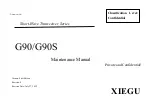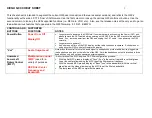
Base Station Setup and Operation
25
3 Base Station Setup and Operation
Real-Time Kinematic (RTK) operation provides centimeter-level precision by
eliminating errors that are present in the GNSS system. For all RTK operations, you
require both a rover receiver and a source of corrections from a base station or
network of base stations.
A base station consists of a receiver that is placed at a known point. The receiver tracks
the same satellites that are being tracked by the rover receiver simultaneously. Errors
in the GNSS system are monitored at the base station, and a series of position
corrections are computed. The messages are sent through a radio link to the rover
receiver, where they are used to correct the real time positions of the rover.
This chapter provides the information to help you identify good setup locations,
outlines basic precautions that you need to take to protect the equipment, and
describes the conventional process to set up the base station and the configuring
procedure that required for transmitting correction data.
3.1
Base Station Setup Guidelines
For good performance, the following base station setup guidelines are recommended:
•
Place the GNSS receiver in a location on the worksite where equal range in all
directions provides full coverage of the site.
•
Place the GNSS antenna in a location that has a clear line of sight to the sky in all
directions. Do not place the antenna near vertical obstructions such as buildings,
deep cuttings, site vehicles, towers, or tree canopy.
•
The GNSS antenna must have a dear line of sight to the sky at all times during
operation.
•
Place the GNSS and radio antennas as high as practical. This minimizes multipath
from the surrounding area, and enables the radio to broadcast to the maximum
distance.
•
Choose the most appropriate radio antenna for the size of the worksite. The
higher the gain on the antenna, the longer the range.
•
Make sure that the GNSS receiver does not lose power. To operate continuously
for more than a few hours without loss of power at the base station, provide
external power. When you use an external power supply, the integrated battery
provides a backup power supply, enabling you to maintain continuous operation
through a mains power failure.
•
Do not locate a GNSS receiver, GNSS antenna, or radio antenna within 400
meters (about 1,300 feet) of transmitters, such as a power radar or cellular
















































